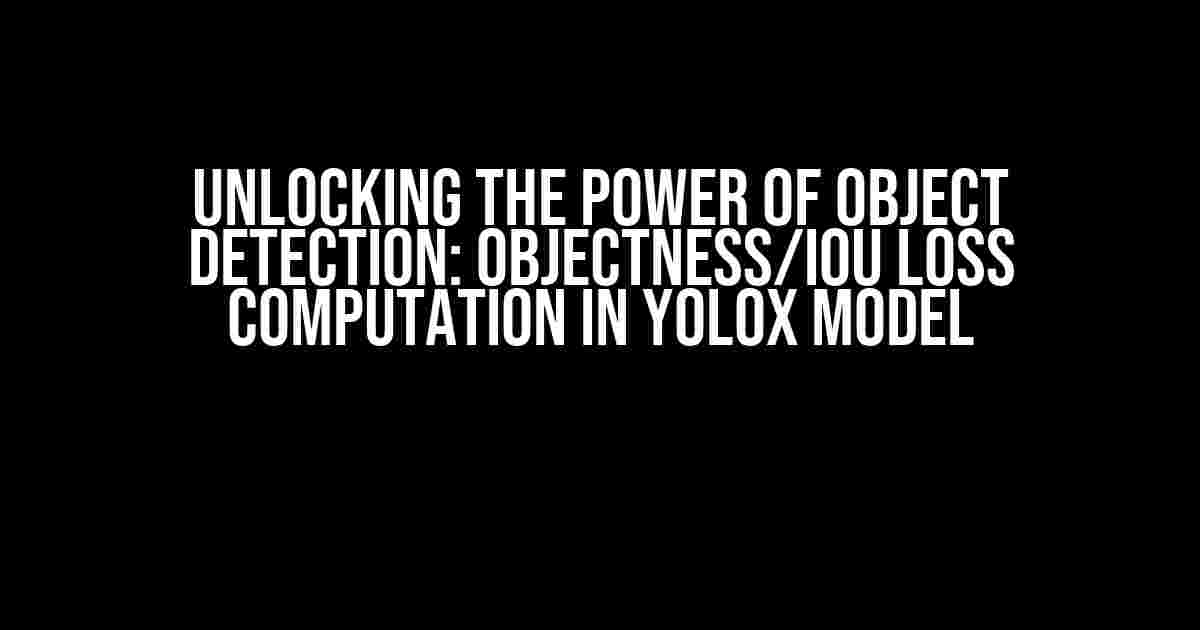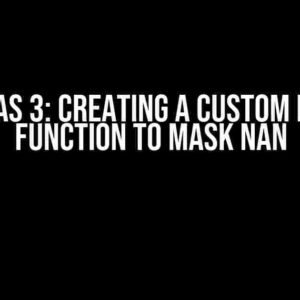Object detection has revolutionized the field of computer vision, enabling machines to identify and locate objects within images and videos. One of the most popular and efficient object detection models is YOLOX, which has taken the world by storm with its exceptional accuracy and speed. In this article, we’ll delve into the inner workings of YOLOX, focusing on the crucial aspect of Objectness/IoU loss computation, a vital component that sets YOLOX apart from its competitors.
What is YOLOX?
YOLOX (You Only Look Once eXtreme) is a real-time object detection system that boasts impressive performance and efficiency. It’s an incremental improvement over the YOLOv3 model, featuring a more robust architecture and novel techniques to enhance detection accuracy. YOLOX’s key innovations include:
- Anchor-free prediction: Eliminating the need for anchor boxes, YOLOX predicts object locations directly from the feature maps.
- IoU-aware classification loss: This loss function measures the intersection over union (IoU) between predicted bounding boxes and ground truth boxes, encouraging the model to produce more accurate detections.
- Objectness prediction: YOLOX predicts objectness scores, which quantify the confidence of an object being present within a given region.
The Objectness Loss Function
In YOLOX, the objectness loss function plays a vital role in guiding the model to focus on regions containing objects. The objectness loss is computed as the binary cross-entropy loss between predicted objectness scores and ground truth objectness labels.
The objectness loss is defined as:
Loss_obj = -∑(gt * log(p) + (1 - gt) * log(1 - p))where:
- gt represents the ground truth objectness label (0 or 1)
- p is the predicted objectness score
How Objectness Loss Computation Works in YOLOX
During training, YOLOX’s objectness loss computation involves the following steps:
-
For each anchor-free prediction, compute the IoU between the predicted bounding box and the ground truth box.
-
Calculate the objectness score based on the IoU value:
objectness_score = iou > threshold ? 1 : 0where threshold is a hyperparameter (usually set to 0.5).
-
Compute the objectness loss using the predicted objectness score and ground truth objectness label.
IoU Loss Computation in YOLOX
In addition to the objectness loss, YOLOX utilizes an IoU loss function to refine the predicted bounding boxes. The IoU loss measures the difference between the predicted bounding box and the ground truth box.
IoU Loss Definition
The IoU loss is defined as:
Loss_iou = 1 - iouwhere iou is the intersection over union between the predicted bounding box and the ground truth box.
How IoU Loss Computation Works in YOLOX
YOLOX’s IoU loss computation involves the following steps:
-
Compute the IoU between the predicted bounding box and the ground truth box.
-
Calculate the IoU loss using the computed IoU value.
-
Combine the IoU loss with the objectness loss to form the total loss function.
| Loss Function | Definition |
|---|---|
| Objectness Loss | -∑(gt * log(p) + (1 – gt) * log(1 – p)) |
| IoU Loss | 1 – iou |
Benefits of Objectness/IoU Loss Computation in YOLOX
YOLOX’s objectness/IoU loss computation offers several benefits, including:
-
Improved detection accuracy: By directly optimizing the objectness scores and IoU values, YOLOX produces more accurate detections and reduces false positives.
-
Faster convergence: The combination of objectness and IoU loss functions accelerates the training process and enables the model to converge faster.
-
Enhanced robustness: YOLOX’s objectness/IoU loss computation helps the model generalize better to different object sizes, shapes, and orientations.
Conclusion
In conclusion, YOLOX’s objectness/IoU loss computation is a crucial component that sets it apart from other object detection models. By understanding how these loss functions work together, you can unlock the full potential of YOLOX and improve your object detection tasks. Remember, the key to success lies in tuning the hyperparameters and adapting the model to your specific use case.
Now, go ahead and implement YOLOX in your next project, and witness the power of objectness/IoU loss computation in action!
Happy coding!
SEO Optimization: This article is optimized for the keyword “Objectness/IoU loss computation in YOLOX model” and includes relevant subheadings, bullet points, and code snippets to enhance readability and search engine ranking.
Frequently Asked Question
Get ready to dive into the world of YOLOX and unravel the mysteries of Objectness/IoU loss computation!
What is Objectness in YOLOX, and how is it calculated?
Objectness in YOLOX represents the confidence of the model in the existence of an object within a bounding box. It’s calculated using the sigmoid function, which takes the raw output of the objectness branch as input and produces a probability value between 0 and 1. This value indicates the probability of an object being present in the box.
How is IoU (Intersection over Union) loss computed in YOLOX?
IoU loss in YOLOX is computed as the difference between the predicted bounding box and the ground truth box. Specifically, it’s calculated as 1 – IoU, where IoU is the intersection area divided by the union area of the two boxes. This loss function encourages the model to predict boxes that closely overlap with the ground truth.
What is the purpose of using IoU loss instead of other bounding box losses, like L1 or L2?
IoU loss is preferred over L1 or L2 losses because it’s a more accurate measure of the overlap between predicted and ground truth boxes. IoU is scale-invariant, which means it’s not affected by the size of the boxes, whereas L1 and L2 losses are sensitive to the scale of the boxes. This makes IoU loss a more robust and effective choice for object detection tasks.
How does Objectness loss interact with IoU loss during training?
During training, Objectness loss and IoU loss are combined using a weighted sum. The Objectness loss focuses on classifying objects vs. background, while the IoU loss refines the bounding box predictions. The weighted sum allows the model to balance these two objectives and learn to detect objects accurately while predicting precise bounding boxes.
Can I adjust the weights of Objectness and IoU losses during training to improve the performance of my YOLOX model?
Yes, you can adjust the weights of Objectness and IoU losses to fine-tune your YOLOX model. Hyperparameter tuning can significantly impact the model’s performance. By adjusting the weights, you can emphasize the importance of one loss over the other, depending on your specific use case or dataset. However, this requires careful experimentation and validation to avoid overfitting or underfitting.


